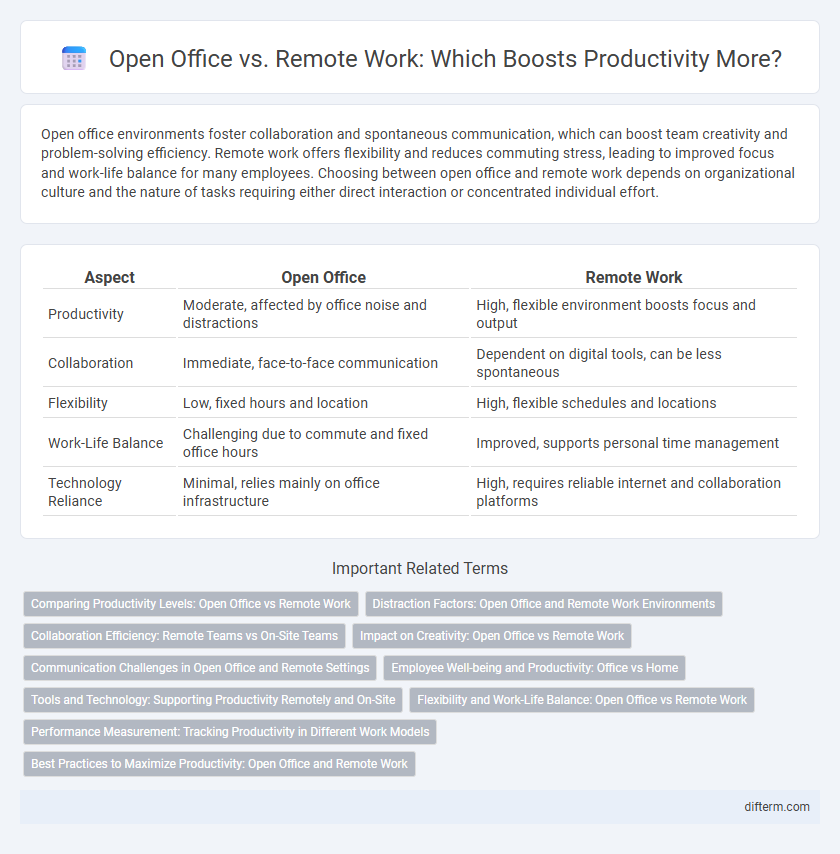Open office environments foster collaboration and spontaneous communication, which can boost team creativity and problem-solving efficiency. Remote work offers flexibility and reduces commuting stress, leading to improved focus and work-life balance for many employees. Choosing between open office and remote work depends on organizational culture and the nature of tasks requiring either direct interaction or concentrated individual effort.
Table of Comparison
| Aspect | Open Office | Remote Work |
|---|---|---|
| Productivity | Moderate, affected by office noise and distractions | High, flexible environment boosts focus and output |
| Collaboration | Immediate, face-to-face communication | Dependent on digital tools, can be less spontaneous |
| Flexibility | Low, fixed hours and location | High, flexible schedules and locations |
| Work-Life Balance | Challenging due to commute and fixed office hours | Improved, supports personal time management |
| Technology Reliance | Minimal, relies mainly on office infrastructure | High, requires reliable internet and collaboration platforms |
Comparing Productivity Levels: Open Office vs Remote Work
Remote work often leads to higher productivity due to fewer distractions and greater flexibility in managing work schedules compared to open office environments. Open offices can increase collaboration but frequently result in noise and interruptions that decrease individual focus and output. Studies indicate remote employees complete tasks more efficiently, with up to a 20% increase in productivity versus their open office counterparts.
Distraction Factors: Open Office and Remote Work Environments
Open office environments often suffer from noise distractions and frequent interruptions, reducing overall productivity due to lack of privacy and constant visual stimuli. Remote work environments can minimize these distractions if dedicated quiet spaces are maintained, but they also introduce challenges like household interruptions and digital overload. Effective noise-canceling tools and structured schedules are essential to mitigate the unique distraction factors in both settings.
Collaboration Efficiency: Remote Teams vs On-Site Teams
Remote teams leverage digital collaboration tools such as Slack, Microsoft Teams, and Zoom to maintain seamless communication and real-time project updates, often resulting in higher flexibility and faster decision-making compared to traditional open office environments. On-site teams benefit from immediate face-to-face interactions, fostering spontaneous brainstorming sessions and quick issue resolution but may experience interruptions and distractions common in open office layouts. Studies show that hybrid models combining remote work and on-site presence can optimize collaboration efficiency by balancing focused individual tasks with interactive team engagement.
Impact on Creativity: Open Office vs Remote Work
Open office environments foster spontaneous interactions and real-time collaboration, which can spark creative ideas through immediate feedback and diverse perspectives. Remote work offers solitude and flexibility, allowing individuals to engage in deep focus and uninterrupted creative processes. Balancing open office dynamics with remote work flexibility can maximize creativity by combining collaborative energy with personalized concentration.
Communication Challenges in Open Office and Remote Settings
Open office environments often face communication challenges due to noise distractions and lack of privacy, which can hinder focused collaboration and reduce overall productivity. Remote work settings struggle with asynchronous communication, potential misunderstandings, and technology reliance, impacting real-time feedback and team cohesion. Effective communication tools and clear protocols are essential to overcome these obstacles in both open office and remote work environments.
Employee Well-being and Productivity: Office vs Home
Employee well-being and productivity often improve in remote work settings due to flexible schedules, reduced commute stress, and personalized work environments, which enhance focus and job satisfaction. Open office environments can foster collaboration and quick communication but frequently lead to distractions, noise, and decreased privacy, negatively impacting concentration and mental health. Studies indicate remote employees report higher productivity levels and better work-life balance compared to their in-office counterparts, emphasizing the value of autonomy and tailored workspaces in driving performance and well-being.
Tools and Technology: Supporting Productivity Remotely and On-Site
Open office environments utilize shared technology such as interactive whiteboards, centralized printers, and high-speed Wi-Fi to facilitate collaboration and immediate access to resources. Remote work depends heavily on cloud-based software like Microsoft 365, Slack, and Zoom, enabling seamless communication and real-time document sharing regardless of location. Advanced productivity apps and virtual private networks (VPNs) enhance security and efficiency, bridging technological gaps between on-site presence and remote setups.
Flexibility and Work-Life Balance: Open Office vs Remote Work
Remote work offers greater flexibility by allowing employees to customize their schedules and work environments, leading to improved work-life balance. Open office setups often require fixed hours and can increase distractions, potentially reducing productivity and employee satisfaction. Emphasizing autonomy and comfort, remote work supports mental well-being and can enhance overall efficiency.
Performance Measurement: Tracking Productivity in Different Work Models
Performance measurement in open office environments often relies on direct supervision and visible task completion, while remote work demands digital tools like time-tracking software, project management platforms, and output-based metrics. Studies indicate that productivity metrics must adapt to communication styles and autonomy levels inherent in each model, emphasizing results over hours logged. Effective tracking combines quantitative data with qualitative feedback to provide a comprehensive view of employee performance across both settings.
Best Practices to Maximize Productivity: Open Office and Remote Work
Implementing clear communication protocols and utilizing collaborative tools like Slack or Microsoft Teams enhances productivity in both open office and remote work environments. Structuring the day with defined work blocks and regular breaks helps maintain focus and reduce burnout regardless of location. Encouraging personalized workspaces supports comfort and efficiency, optimizing output whether employees are on-site or remote.
open office vs remote work Infographic

 difterm.com
difterm.com